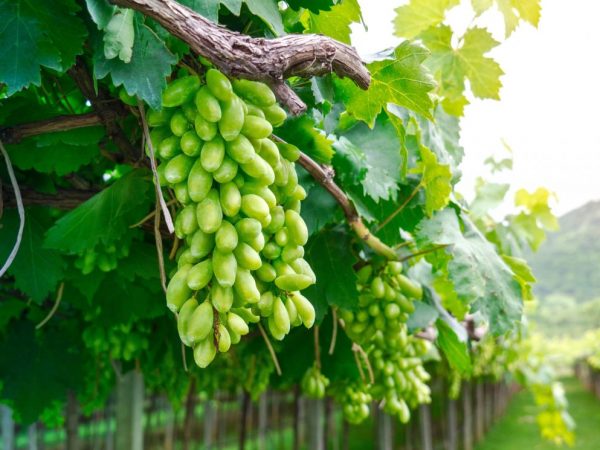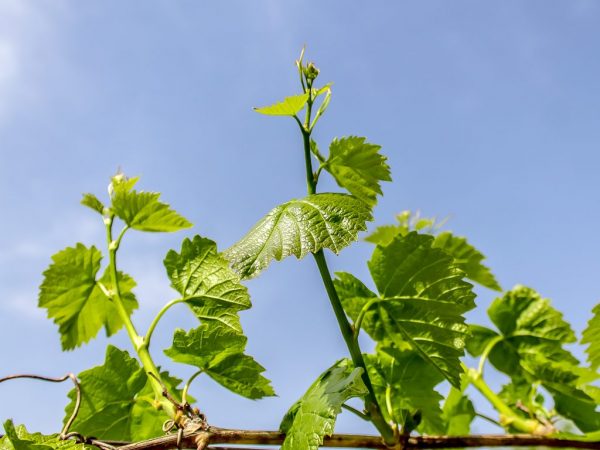Characteristics of Dixon grapes
The Dixon grape is a relatively new variety that has already gained public recognition. The main advantages are high yields and frost resistance. Suitable for growing in all regions of the country.

Characteristics of Dixon grapes
Characteristics of the variety
The Dixon grape variety was bred in Russia at the beginning of 2014. It was obtained as a result of pollination of the Burdak variety.
This species is self-pollinated, it is customary to refer to it as an early grape variety, the growing season lasts only 110 days.
Description of the plant:
The bushes are low, up to 4 m. The stems are dense, the root system is well developed. Flowering occurs mainly in the female type. This does not prevent the bushes from pollinating themselves on their own.
- The weight of the bunches is up to 1500 g;
- Pink berries;
- Productivity is high: from 1 bush to 15 kg.
Taste features and purpose
The taste of Dixon grapes varies, depending on the conditions of care and the region of location. In the southern regions, it is sweeter. In areas with cold climates, there is a sour taste on the palate.
According to the description of the variety, Dixon wine is suitable for universal use: fresh or dessert sweet wine.
Growing features
Planting is carried out in the fall, before the onset of long frosts. The ideal time is October.
The landing site should be well lit by the sun and protected from drafts. The acidity of the soil should not exceed 4%, otherwise the roots will not develop correctly (the growth of the bush will slow down and the number of ovaries will decrease).
A week before planting, you need to loosen the soil and dig a hole 60x80 cm in size.

You need to protect the plant from drafts
When choosing a seedling, give preference to grafted and healthy individuals, since they are more resistant to frost and disease. 4 kg of humus are poured into the bottom of the pit. After 5-7 days, the planting itself begins.
Planting the Dixon grape variety implies that the root collar should be located above the ground. This will protect the crop from root rot. The roots are spread over the pit and covered with earth. After that, it is important to water the bush with 10-15 liters of warm water. A support is installed nearby, to which a bush is tied. The distance between seedlings is 4-6 m.
Care procedure
Water the plant at intervals of 10-15 days. At least 25 liters of warm water are poured under the root. Weeding should be done after each watering. For the first few years, weeding is carried out carefully so that the young seedling does not deform or break. Remove weeds every week that cause pests to grow.
Top dressing is carried out both with organic fertilizers and mineral fertilizers. Organics are used to mulch the soil before winter. At the end of October, you should mix 1 part of compost, 2 parts of humus and 2 parts of straw, and with this mixture, mulch the root part. Before flowering, fertilizing is carried out with potassium nitrate (30 g per 10 l of water). After flowering, a superphosphate solution (40 g per 10 l of water) is used as fertilizer. 1 bush should have 25-30 liters of solution.
Pruning is carried out in the spring.It is necessary to remove dry and sore areas. On the shoots, no more than 6-8 eyes should remain, thanks to which the fruit is set. All other eyes are removed, because antennae will grow from them, which take on a lot of nutrients.
Pests and diseases
Dixon grapes suffer from bacteriosis and moniliosis.
- It is impossible to get rid of bacteriosis, so you will have to completely eradicate the diseased bush.
- In the fight against moniliosis, a solution of Bordeaux liquid will help (10 g per 10 liters of water).
The Dixon variety is resistant to the invasion of parasites. For prevention, it is worth regularly removing weeds, and every month spraying with copper sulfate (50 g per 10 liters of water).
Conclusion
Grapes of this type are the best option for those who live in the northern regions of the country. It is able to survive temperatures down to -25 ° C. Growing this species on your site, you will be calm about the safety of the plant and yield indicators, which are unchanged every year.


